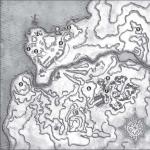Make a penknife with your own hands. How to make a folding knife yourself, where to start, choosing the material of the blade and handle, making handle dies, assembling a homemade folding knife
Well, to complete the review of the anatomy of folding knives, we should consider one more the most important detail, for some reason in the above article only mentioned in passing: fuse / lock. The lock is the mechanism that locks the knife blade in the "open" position and prevents it from spontaneously closing. For modern folding knives, many various designs castles, it's hard to say which one is better - each has its own characteristics.
Liner lock
The most common type of lock, relatively easy to manufacture and yet reliable enough for most everyday tasks. The lock mechanism is based on a flat spring, which is part of the liner and rests against the blade shank when the knife is opened. You should pay attention to how much the spring enters the shank - this largely determines the reliability of the lock. This distance must be greater than the thickness of the spring itself, otherwise the knife may fold from light pressure. 
Framelock (monolock, integral lock)
A variation of the liner lock. The only difference is that the part of the knife handle, which in such cases is made of metal, plays the role of the locking plate. This adds strength to the entire castle, because. it becomes harder to deform the spring in this case. In addition, the hand holding the knife additionally presses the locking plate. 
back lock
In locks like back lock the blade shank is fixed from the side of the butt by a spring-loaded rocker lever. These locks are more difficult to manufacture due to the fact that the part of the rocker that engages and the slot on the shank must be fairly accurately fitted to each other. Otherwise, the blade is either poorly fixed (the rocker does not fully enter the shank) or staggers (the rocker enters freely). And even if they are identical, at a certain load vector there will be a slight backlash, which is due to the design itself. 
In 2008, Cold Steel improved the back lock and introduced its new creation - Tri-Ad Lock. The original design received minor improvements: a locking pin was added, which takes on almost all the mechanical load, the geometry of the rocker arm engagement itself and the groove in the shank was redesigned, and the hole of the rocker axis was made oval. As a result, the strength has increased radically, and when the contacting parts are worn, the rocker will simply change its position without increasing the backlash of the structure. 
compression lock
It is a hybrid of liner lock and (to some extent) back lock. The peculiarity is that the flat spring rests on the shank not from behind, as in liner lock, but from above. Another feature is that the spring on one side enters the shank, and on the other side rests against the locking pin. An indisputable plus of the mechanism - when closing the knife, not a single finger will be in the way of the blade. 
Levitator lock
Knives with locks of this type are produced by Benchmade. Due to its characteristics, the lock can only be used in knives with a metal handle. A special pattern is carved on the handle, forming a springy plate, when pressed, the rod entering the blade shank moves and releases the blade. 
Clutch lock
Under the name Viroblock is used in most modern knives trademark Opinel. The blade is fixed by a swivel metal sleeve with a longitudinal slit. In the extreme position, the clutch blocks the opening of the blade, and when the knife is in the open position, turning the clutch in any direction blocks its closure. With a small cost of such knives, the lock in them is simply excellent. 
pin locks
The AXIS lock type is a patented highlight of Benchmade. The blade is fixed with a spindle-shaped pin, which enters the corresponding grooves on the knife shank. In this case, the fixation is carried out both in the open and in the closed position of the knife, which makes it possible to avoid accidental closing of the blade. According to the results of testing the strength of locks for budget knives by knifelife.ru enthusiasts, AXIS turned out to be the most durable in the Benchmade Griptilian 551 model. The main enemy of such a lock is dirt, which can disable the knife. 
Arc lock, patented by SOG, is very similar in principle to AXIS, but has slight differences - the pin is additionally attached to a small swinging rocker inside the handle. 
rolling lock- another lock from Benchmade. Here the pin is completely inside the handle and is actuated by an L-shaped lever with a peg brought out. 
Ultra Lock- another type of pin lock, this time from Cold Steel. In this version, the pin moves along a U-shaped groove in the blade shank. The locking rod locks the blade in extreme points which ensures a secure fit in the open and closed positions. 
push-button locks
lock type button lock(or plunge lock) is most commonly found on automatic knives. A spring-loaded button-pin of variable diameter, when pressed, moves with a thinner part into the plane of the blade and releases it. Holds the blade both open and closed. The quality of locks of this type depends entirely on the manufacturer. In general, they can be very durable, but they are afraid of dirt. 
Axial lock- a rather unusual lock that most inexperienced knife lovers introduce into mild condition thoughtfulness. Such a knife opens and closes by pressing the axis of the knife and turning it with your thumb. On the axis there are protrusions that engage with the grooves on the blade and in the handle. 
Stud Lock
A moving pin lock design found on knives in the Kershaw range. When opened, a spring-loaded peg on the knife blade engages with a notch in the front of the handle. To unlock the blade, you need to move the peg towards the tip. With proper dexterity, closing the knife is solid and fast, and the lock guarantees proper strength. 
Crossbar locks
Lock ram safe lock installed on a rather unusual and recognizable Cold Steel Pocket Bushman knife. For all its technological simplicity, the lock is very powerful. In it, the blade shank is locked with a rod (crossbar), which moves parallel to the butt. The rod on the opposite side of the blade is pressed by a rigid spiral spring, and in order to open the knife, it is necessary to pull the lanyard. Opening (and even more so closing) with one hand is extremely difficult, but in order to break such a lock, you will have to work hard. 
Design bolt lock differs from the previous lock by the presence of a peg attached to the crossbar and brought out to side surface handles. According to the principle of operation, the lock is very similar to pin structures. 
gear lock
In construction ratchet lock(or cogwheel lock) the rounded shank of the blade is made in the form of a comb with straight or slightly curved teeth, and the locking is done by a slip plate with a slot for one tooth. When the knife is opened, the plate rises, and all the teeth of this half gear pass through it, and in order to close the knife, it is necessary to manually lift the retainer plate (most often by the ring). The lock is traditional for Spanish Navaja knives, but is also found on South African okapis (and their modern incarnation Cold Steel Kudu). 
Balisong
It is difficult to call the design of a balisong knife (popularly “butterfly”) a lock, and, nevertheless, we will describe this method of fixing the blade. When folded, the blade is closed by halves of the handle on both sides. When opened, each half rotates 180 degrees; in some designs they are then snapped together, while in others they are simply held together with one hand. 
Slip-joint
Perhaps one of the most simple types lock, which has found its application in many budget models of tourist knives. AT extreme positions the blade is held from above by a rounded shank with a flat spring. The lock does not provide a rigid fixation of the blade, but nevertheless does not allow the blade to accidentally fold and injure the fingers. 
Friction fixation
So-called friction folder- the oldest design of a folding knife, the blade in which is held open due to the friction of the shank against the handle in the area of \u200b\u200bthe axis. In most of these knives, there is a lever on the shank, which protrudes from the handle when the knife is closed. By pressing it, you can remove the blade from the handle, and then open the knife by the blade. In an open knife, the same lever is pressed by hand during operation and additionally prevents folding. According to this principle, the well-known straight razors, European medieval peasant knives and Japanese higonokami knives were made. 
Manufacturing should begin directly with the blade. First of all, we mark the place for the axial hole. We drill it and, already guided by it, we make further marking of the blade. If you do the opposite and mark and cut the blade along the contour, and only then drill a hole, then during the drilling process, especially in hardened workpieces, the drill can lead to the side and all dimensions will “float away”.
Transferring the contours of the blade to the workpiece, we begin to make the blade. We grind with the help of a grinder and emery along the contour. For the convenience of holding the blade in the process of removing the descents, the blade itself is not cut off from the workpiece yet and the heel of the blade is not formed.
Various tools can be used to remove slopes: grinders, emery, flat grinders, grinders. I do a rough turning of the slopes on emery and a fine one on a flat grinder.
Next, we proceed to the manufacture of side dies.
Next, we drill a hole in the dies for the pin of the blade stopper, install the axis and stopper pin, install the blade and the second die. We move the blade to the open position and mark on the die the position of the heel of the blade, more precisely the place where the lock liner should rest. Next, mark the liner and proceed to cut it.
Having prepared the ribs in this way, we proceed to their installation on the dies. The methods are different: soldering, riveting, spot welding, etc. The most accessible are soldering and riveting.
For soldering, you will need a soldering iron, soldering acid, solder and a heat source. As a soldering iron, it is best to use a massive piece of copper, which is heated in a burner flame. soldering acid It is hydrochloric acid etched with zinc. POS-60, POS-90 are suitable as solder. Before soldering, it is necessary to clean and tin the soldering points. It is cleaned with sandpaper, a file. After stripping, we coat the soldering points with acid, take, on a well-heated soldering iron, a piece of solder and tin the surface. In the process of tinning, it is necessary to ensure that there are no gaps left and that the entire surface is covered with an even layer of solder. High-quality tinning and soldering are possible only with good heating of the parts.
After tinning, rinse the parts well in water with soda, removing acid residues. Next, we clamp the tinned parts in a vise and begin to warm up with a burner from different sides. To reduce heat loss, it is necessary to lay a thermally insulating material under the vise jaws; fragments of ceramic tiles are well suited. As it warms up, we tighten the vise until droplets of solder come out between the parts, after which the heating can be stopped.
The soldering of the right fitting has some peculiarities: first, we solder the axis of the knife into the die, and then solder the fitting, while instead of one of ceramic tiles use a piece of tube larger than the diameter axis.
 |
|
| So, all the components of the knife are ready, it remains to assemble the knife, once again make sure that the lock is working correctly. Adjust if necessary. For smoother operation of the mechanism, it should be lubricated with machine oil. After some time of operation, the parts of the mechanism should be rubbed in, the blade will rotate easily and smoothly, the liner plate will rise slightly. |
|
  |
|
Knife - very useful tool, they can defend themselves, sharpen a stick, cut sausage or use instead of a screwdriver if necessary. In order for the knife to always be with you, it must either have protective case, or should add up. The second option is more convenient, since such a knife will be more compact, and you will not be able to lose the case. Folding knives come in a wide variety of designs, we will consider the simplest of them.
The author decided to make the handle of his knife exclusively from wood. This material is available and easy to work with. The author used only hand tools. The main focus of the article is on the manufacture of the handle. You can find a blade either ready-made from an old knife, or you can grind it yourself, it's not difficult. So, let's start making a knife.
Materials and tools used
List of materials:
- blank for the blade;
- wooden plank;
- steel rod (as an axis for the blade);
- glue for wood;
- electrical tape;
- oil for impregnation.
List of tools:
- jigsaw;
- a hacksaw for wood;
- drill;
- marker;
- planer;
– sandpaper;
- files;
- vice;
- clamps.
Knife making process:
Step one. Cut out blanks for the handle
To make a handle, you need a piece of board. You can use different types of trees according to your preference. But just remember that harder rocks will be more difficult to process. We will cut the board lengthwise into two halves, as a result we will get two blanks. Here you will need to correctly consider the thickness of the board.
The blade is applied to the board and circled. Now we know how long the handle should be in order for the blade to go into it. Consider also the location of the locking pin and so on. Having done everything necessary calculations, clamp the board in a vise in a vertical position and proceed to cutting. The author first outlines the cut line with a jigsaw, and then a hacksaw with a wide blade comes to the rescue. Slowly, slowly, cut the board into two halves. Step two. We manufacture and install the axis of the blade
Step three. We finalize the halves of the handle
Step four. Internal brace
Step five. Drilling axle holes
Step six. Gluing
We clamp the whole thing with several clamps and let the glue dry completely. Epoxy dries for about a day, it is better to take about the same amount of time for wood glue. Step seven. Final processing
At the same step, you can sharpen the blade, fine sandpaper dipped in water is perfect for this. Step eight. Impregnation
That's all, the manufacture of the knife has come to an end. As a result, we have a small handy pocket knife. Do not forget that the handle is made of wood, so the knife will not be able to withstand a high load on the blade. However, for most household work, its strength should be enough. That's all, good luck and take care! Dec 21, 2018 Gennady



The blade is attached to the handle with a single metal axis. We are looking for a rod that is suitable in diameter and cut off the desired piece. We drill a hole in the blade of such a diameter that the axis fits snugly into the hole. The blade should not dangle on the axis.

After the board was sawn into two parts, we got two halves. Each of them needs to be properly aligned and sanded, since after cutting the parts will have a lot of irregularities. You can level them with a planer or by grinding, which is safer. At the end, sand the parts with sandpaper so that they become perfectly smooth.

Between the two halves there is another piece of wood, with the help of which we get the desired gap. We select the gap in accordance with the thickness of the blade. The main idea is that the blade fits snugly into the handle and does not fall out. There are no additional fasteners here. Also, this part will act as a stop for the blade. The wood for this part is dense, like oak, maple, and so on.


Attach the blade to the workpiece and drill holes for the axle. It should be inserted tightly into the part. Try to collect all the parts in a heap and make sure that all the parts are made correctly. The blade must not spontaneously fall out of the handle. If so, you need to reduce the gap between the halves of the handle.



Epoxy glue is suitable for gluing, but the author decided to use wood glue, it is also quite enough here. We apply glue to the "spacer" on both sides, and then glue the halves to it on the sides. As for the axis on which the blade rests, it is highly desirable to apply epoxy glue to it before assembly, so that it will adhere securely to the handle. But be careful, if the glue sticks to the blade, you may not open the knife after it's made.



When the glue dries, remove the clamps. You now need to cut off the protruding parts of the axis, for this we use a hacksaw.
At the end, you will have to form the desired profile of your pen. This can be done manually, as the sizes here are small. We take files and form the desired profile. Then we switch to sandpaper. Finally, we use the finest sandpaper to bring the product to the ideal.

Wood is a very insidious material, it instantly changes in size, cracks, deforms if moisture gets on it. To avoid these unpleasant consequences, the tree must be protected. It will save you here linseed oil or any other designed for wood processing. Do not use mineral oils because they don't dry out. We impregnate the handle everywhere, both outside and inside. Let the oil dry. Instead of oil, you can also easily use varnish.



A variety of types of knives does not dry out the theme of their manufacture on your own. The knife is an ideal assistant not only in household but also for hunting, fishing and other field conditions. Some people probably need a knife for tough self-defense. But it is better to still try to avoid using a knife as a weapon of self-defense. There are less dangerous to human life and more legal self-defense items, so to speak. But life is life and you never know when, how and with what it will have to be protected. Hiking and Hunter knives it is convenient to carry in a sheath, but in urban conditions, a cleaver on a belt will look pretty wild and will naturally attract the close attention of law enforcement agencies. Therefore, there are folding knives that are convenient to carry in a trouser pocket. We are going to make this today.
Naturally, it will be much easier to buy a folding knife, but people come to this site who do not pursue simplicity, but try to do everything with their own hands. The article is introductory and is aimed at readers who already have an idea about the manufacture of knives, so the description is given quite briefly; but from the photographs you can understand almost every step of the work.
To make a folding knife, we need a titanium plate, although you can use stainless steel or some other good steel. Naturally, it all starts with the manufacture of a template, the shape of which you then transfer to a steel strip.
To begin with, we will make the liners of the handle of the folding knife. We outline the shape of the liner on a titanium plate and cut it out using any tool available to you. Next, we do a rough processing of the liner, grinding off excess metal on emery and files. Making the second liner. To do this, we apply the finished liner to a strip of metal and drill through two holes. We cut the threads into them, fasten the liners with screws without a cap and cut out the second liner, using the first one as a template. Next, we process the paired liners on sandpaper and files, approaching as close as possible to the contour line of the liner.
It was the turn of the manufacture of the blade of the folding knife and the back of the handle. We act in exactly the same way: templates, transfer to a titanium strip, sawing and processing on emery.
We drill holes in the liners for attaching the back of the knife handle. We assemble the knife and look where there are inconsistencies, cracks. If necessary, we refine these places, with files, achieving the perfect combination of all parts of the folding knife.
We dress the second liner and drill additional holes for attaching the back of the knife. You can fasten the parts of the knife handle with the help of special screws, having previously cut the threads in the holes with a tap. The screws are convenient because, if necessary, the knife can be easily disassembled and any modification can be performed. We flare all the holes for the screws with a larger drill so that the screw head does not stick out above the surface of the liner.
Next, we cut out the two upper and two lower metal lining of the knife handle. Glue them to the liners with superglue. Now we drill holes for the screws through the liners into the metal lining. The holes in the overlays should not be through. Now we put the knife in a bath of acetone to dissolve the superglue.
We chamfer the blind holes of the metal lining of the folding knife and cut the threads into them. We fasten the lining to the liners with screws. We customize the lining, under the shape of the liners, grinding off excess metal on the emery.Next, we make the final grinding of the knife handle.
From the inside, on the front metal plates, we drill recesses under the axis of the blade with a drill sharpened at an obtuse angle. For the axis, we grind the support screws on lathe. We cut the thread with a die.In the back of the handle we cut out a cone-shaped (dovetail) groove for the leaf spring.
All metal parts of the folding knife are hardened using a homemade forge or gas burner.We will make the middle part of the overlays from any available material: wood, bone, plastic, plexiglass, textolite, etc.
We cut and grind the plate, adjusting its shape. The work requires precision, so adjust the middle lining slowly and periodically trying it on. After that, we drill blind holes in the liners for attaching a wooden lining. And cut out L-shaped slots.
All that's left is the lock. We drill holes for the lock at each end of the liner. We connect them with a slit. Then we make a transverse cut and get an L-shaped slot, which forms a blocking plate. We harden it gas burner and bend it to the side by three, four millimeters.
We drill a hole in the corner of the lock plate and press a metal ball into it. The back of this locking ball is ground flush with the spring plane.We sharpen the axis screw, making it a rectangular shape. We mill the slot for the screw in the liner body.We sharpen the fin of the back of the knife handle on both sides. We grind the metal parts of the handles. We make bevels on the blade of a folding knife.
Collecting a knife. But the axis is put on a thin washer, a blade, another washer. Then the second liner is put on. We insert the middle pads, snapping them into the L-shaped holes. We tighten the screws with a flat special wrench.
In the most simple models the blade does not lock in the open position: it will fold if you push it hard enough in the appropriate direction. This is how a classic pocket penknife works. In English literature, a knife equipped with a similar mechanism is called slip joint folder, or a folding knife with a sliding joint (or rather articulation).
I could not find the corresponding Polish term. Oh well, it doesn't matter what it's scientifically called; what matters is how it works. The spring, attached at one end to the upper edge of the handle, with its other end presses on the disc-shaped surface of the back of the blade. And this surface is designed in such a way that both opening and folding the knife causes the spring to bend or unbend; at the same time, it provides a certain resistance, which allows you to keep the knife either in the open or in the closed position (Fig. ). But if in the folded state the spring holds the blade quite reliably, then in the open position such a knife cannot be called one hundred percent safe. In practice, you have little to fear if you only use your knife for light, well-controlled cutting—for example, opening mail or sharpening pencils. Perhaps that is why such models are becoming a thing of the past, now they are produced in small numbers. Even typical multifunction penknives are now increasingly being equipped with mechanisms that allow at least one, the largest (main) blade, to be held open.








